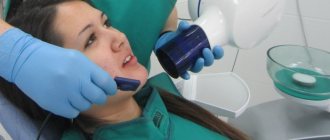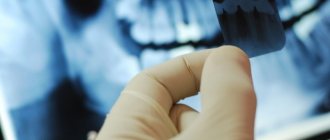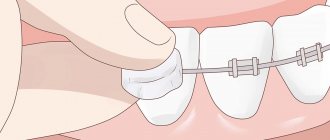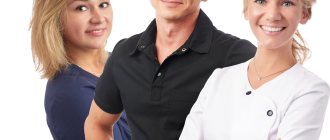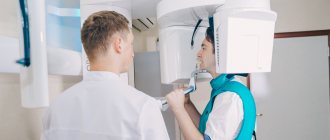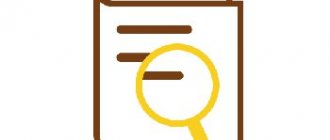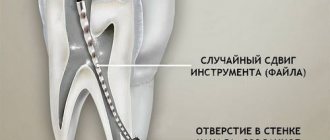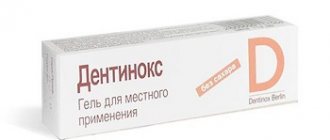Visiography of a tooth is
Dental visiography is the most informative method for diagnosing pathologies of the teeth and jaw, carried out using a special device that operates on the basis of radio frequency radiation.
The procedure is absolutely safe and not contraindicated even in childhood. The radiation exposure to the body is minimal (10 times lower than with classic x-rays). The procedure is also called “radiovisiography”. The main difference between the procedure and classical x-rays is the ability to instantly obtain an image of the area under study not on film, but on a monitor screen. In addition, experts confirm the high quality of the image and the possibility of obtaining a targeted image.
A dental radiovisiograph is used to identify any pathological processes in the teeth or jaw, including surrounding soft tissues and temporomandibular joints. As a result of diagnosis, a specialist can determine hidden processes (including hidden caries), inflammation, maxillofacial injuries, pathologies of the maxillary sinuses, and the condition of the jaw bones. Visiography is also used in dentistry to monitor the progress of treatment and its results.
Requirements for a visiographer in private offices
Since the device reduces the level of radiation, the requirements for a visiograph in private offices are much lower than for analog X-ray equipment.
According to SanPiN 2.6.1.802-99, radiovisiographic equipment (radiovisiography) can be placed in a dental office, which is located in a residential building. The only condition is to ensure compliance with radiation safety requirements within the given office.
For a private office, if you do not have the opportunity to rent a large area, you can work with the device in the main reception room. This is very convenient if the picture is taken during treatment and the patient is sitting with an open tooth. For personal safety, a special apron is used, and the photograph is taken directly by the attending physician.
The requirements for a visiograph are quite simple to fulfill even for a small clinic and a small private dental office. The cost of the device is high, but the ease of operation and regular use allow you to recoup the costs within 1.5-2 years.
There are interesting safe models with a wireless visiograph from the French company Satelec Action Group
This is what this PSPIX 2 radiovisiograph system looks like for reading X-ray images with a preview screen and memory plates.
On the X-ray equipment market in terms of visiography, there are also interesting models from the giant MyRay brand, one of the leaders in the field of developments in radiology. Compact wireless imaging device XPod
allows the dentist to immediately see x-ray images on the display
without using a computer.
The average lifespan of a visiograph is 400,000 images. Use a radiovisiograph in dentistry, because innovative and advanced technologies are the key to success. Order radiovisiographic equipment right now! Take your business to a new level of service.
What does the photo show?
Clinic Dr. Martin successfully uses digital radiovisiography for diagnostic purposes when indicated for therapeutic or surgical treatment.
Computer radiovisiography is increasingly used in endodontics, which deals with the treatment of dentin and pulp. The visiograph images clearly determine the shape and length of the root canals, which makes it possible to flawlessly perform mechanical treatment and filling.
Targeted images of a visiograph allow you to obtain accurate information about the condition of soft and bone tissues for high-quality implantation. Thanks to a detailed study using computer technology, the orthodontist can select the correct size and shape of the implant and monitor the result of its installation, as well as the healing process of the pin.
Dental radiography is performed in dentistry according to indications. The patient is referred by a specialist for diagnostics before planned implantation, installation of braces or any other design/products. The visiograph is able to identify any orthodontic products in the dental system. They are identified in the image in white. Foci of inflammation (granulomas, cysts, etc.) are displayed in dark color. The pathological zone of connective or bone tissue is highlighted in gray shades in the images.
Rules of service
To maintain hygiene conditions, the sensor must be placed in a special polyethylene case before being placed in the patient’s mouth.
For normal operation, the visiograph also requires cleaning using a soap solution or isopropyl alcohol. Before cleaning, you must turn off the power to the device. Since some disinfecting liquids can form explosive compounds when evaporated, in order to avoid ignition when turning on the visiograph after cleaning, some time is required to allow the vapors of these liquids to evaporate from the room.
IMPORTANT. It is extremely dangerous for the device if moisture gets inside the sensor or control unit. If liquid gets on the device board, it can cause a short circuit.
Advantages
Classic X-rays involve exposure to a significant dose of radiation to the body, so the procedure is allowed only a limited number of times during the year, observing time intervals. In addition, the image on such a device is printed on film, which does not exclude distortion of the image.
The operating principle of the radiovisiograph offers significant advantages:
- low level of radiation exposure;
- displaying the image on a computer monitor immediately after the start of the procedure;
- storing data in a computer database;
- transfer of data to a specialist or patient in electronic format, including sending an image using modern methods;
- high quality image with the ability to zoom in and view the desired area in detail;
- availability of using special filters without introducing a contrast agent into the body;
- the ability to take a targeted shot;
- Absolute safety for the patient’s body with no side effects.
Diagnostics using a visiograph is many times faster than when examined using standard X-ray equipment. The photo is taken in a few minutes. And immediately after the examination is completed, the images will be ready.
Software errors and crashes
Another malfunction that users of radiovisiographs sometimes have to encounter is malfunctions in the operation of the software and drivers of the visiograph . When the equipment is delivered, the kit includes a disk or Flash drive with software. It may be required to reinstall all programs and drivers or restore settings in the event of software failures. Errors in the radiovisiograph program occur due to problems with the operating system (most often Windows), hard drive wear, and serious PC hardware problems.
Symptoms:
- The radiovisiograph program does not start
- When starting a program or starting a mode, an error appears (it must be written down or photographed)
- When saving snapshots (images) to the database, nothing happens, a system error appears
How is the diagnosis carried out?
The visiograph is a modern diagnostic device consisting of three main parts: a high-precision sensor, an analog-to-digital converter and a cord connecting the parts of the device. The operation of the visiograph is ensured by a whole complex of parts, including x-ray equipment with a special guide (tube). The device itself has an external resemblance to a tomograph.
The sensor is a silicone chip (digital sensor) that records all the signals that come to it. It is the sensor that transmits the signal to the device, which is formatted into an image with 16-bit quality. The analog-to-digital converter is a monoblock equipped with a USB port for connecting to a computer and a special port for connecting to a sensor. The data received by the sensor passes through the connecting cable to the computer. All information is converted using a built-in program and displayed on a computer monitor.
The diagnostic procedure takes on average 3–5 minutes. The patient sits down on a chair near the visiograph, the specialist adjusts the direction of the X-ray tube in the desired direction and places the sensor against the area being examined. Then the device turns on and a photo is taken.
Main components of the visiograph and x-ray system
- X-ray machine (sighting - intraoral or portable dental)
- Wired (wireless) sensor: Housing
- X-ray sensitive layer
- Matrix
- Control board
- Substrate and insulation
- Cable and connector for connecting the visiograph to a PC
Diagnostics at the clinic Dr. Martin
Visiography is recognized as the best method of modern diagnostics in dentistry when it is necessary to obtain a targeted image that allows one to examine in detail a separate area of the dentofacial structure and joints of the lower jaw.
Clinic Dr. Martin offers dental imaging at an affordable price. Diagnostics can be either a stage of treatment by our specialists or a separately provided service. The cost for the procedure and the image is indicated in the price list on the clinic’s website.
You can make an appointment with a specialist, a consultation or an examination by calling the contact number, or using the website service by ordering a call back from a consultant (“Make an Appointment”).
The main types of radiovisiographs in dentistry, their features and operating principles
So, a radiophysiograph allows you to take images of your teeth using a special sensor, which will transmit them to a computer.
The minimum kit includes an X-ray machine, sensor and computer.
Main types of radiovisiographs:
- Wireless.
- Wired.
Operating principles and features of visiographs
- Wired . After the sensor is applied to the tooth, the X-ray machine will take an image that will go directly to the PC screen.
- Wireless . In this device, the sensor is additionally installed in a special scanner, which reads the image and also displays it on the monitor.
